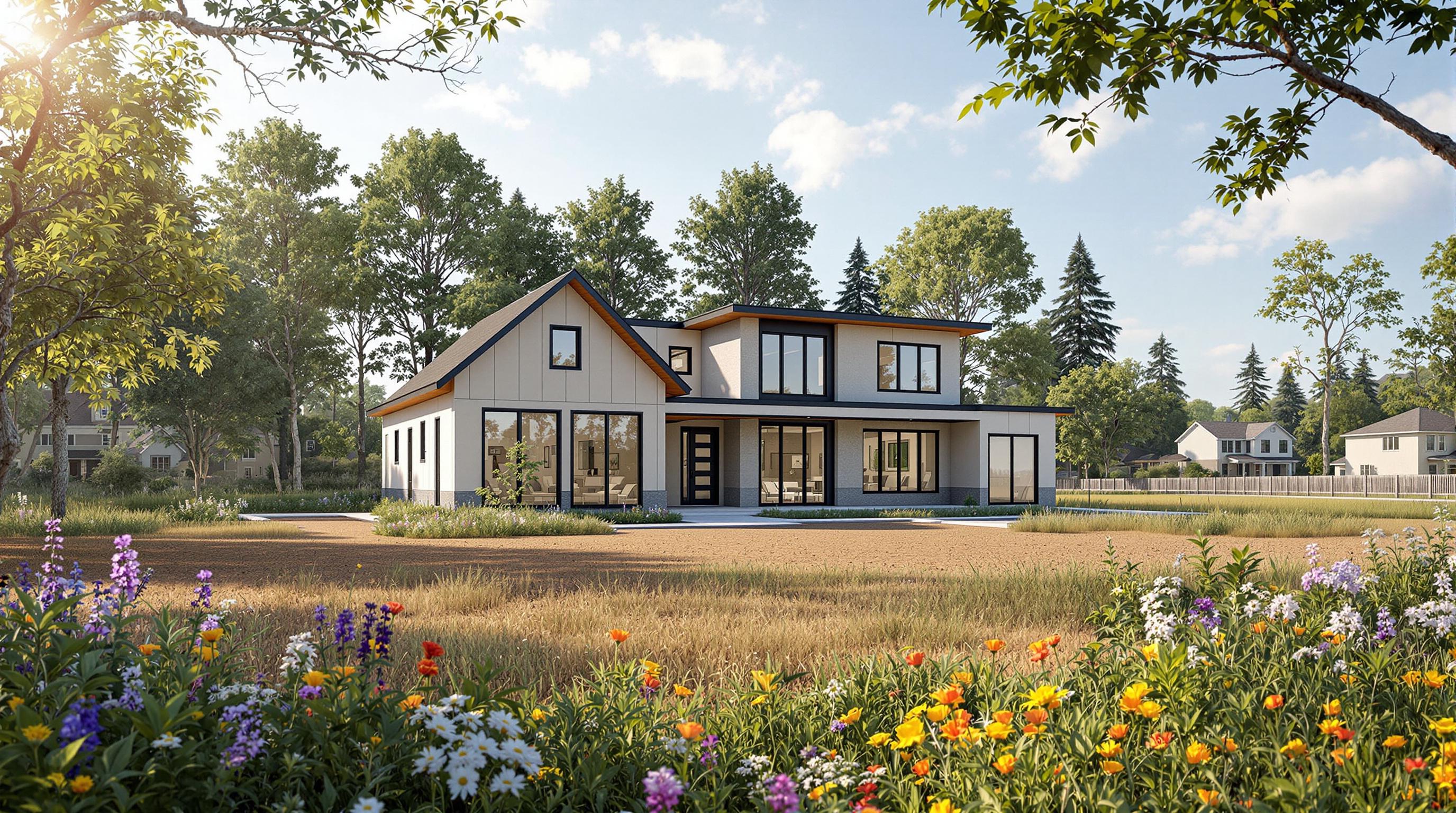Co-living suites are emerging as a potential solution to Halifax's evolving rental market. These living arrangements combine private spaces with shared amenities, but the city currently lacks a clear definition or dedicated regulations for them. Property owners must navigate existing zoning laws, building codes, and design standards to ensure compliance while creating appealing spaces for tenants.
Key points to know:
- Legal Requirements: Co-living suites must adhere to Halifax's zoning rules, density limits, and parking standards. They often fall under multi-unit residential categories.
- Building Permits: Projects need architectural plans, traffic studies, and community consultations. Compliance with fire safety and accessibility codes is critical.
- Design Standards: Focus on unit size, natural light, ventilation, and soundproofing. Energy-efficient systems and smart technologies can boost tenant satisfaction.
- Market Trends: High demand exists among students and young professionals. Well-designed units with modern amenities can generate annual returns of 12–20%.
- Construction Approach: Integrated design-build methods reduce costs and timelines compared to fragmented construction, ensuring smoother project completion.
Halifax's compact urban layout and growing demand for affordable housing make co-living suites an appealing opportunity. By aligning with regulations and focusing on tenant needs, property owners can achieve financial success while addressing the city's housing challenges.
Co-living: Welcome to the New Flatshare | ARTE.tv Documentary

Legal Requirements for Co-Living Suites in Halifax
In Halifax, co-living suites must comply with existing residential zoning and building standards. While the regulations don’t specifically define co-living as a separate category, property owners are expected to navigate these rules within the framework of current guidelines. Let’s break down the key zoning, permitting, and design considerations that shape these requirements.
Zoning and Land Use Rules
Halifax’s zoning regulations classify co-living projects under existing multi-unit residential categories. To get started, property owners should review the zoning rules for their neighbourhood, focusing on factors like unit density, setbacks, lot coverage, and parking requirements. However, co-living spaces can present unique challenges, especially when blending shared common areas with private living units.
For instance, density is often calculated using floor area ratios or units per area, which may not fully account for shared spaces. Parking requirements are another area to watch - while standard ratios are typically enforced, adjustments might be possible in areas with strong public transit and walkable amenities.
Permits and Required Documentation
Getting permits for co-living suites involves several steps and a detailed review process across municipal departments. Here’s what’s typically required:
- Architectural Plans: Detailed layouts showing unit boundaries, shared spaces, and egress routes.
- Traffic Impact Studies: Assessment of how the project affects local traffic patterns.
- Neighbourhood Consultations: Engaging with the community to address concerns and gather feedback.
If a project doesn’t fit neatly within existing zoning rules, a development agreement may be necessary. This allows municipalities to address specific site challenges while ensuring community benefits are considered.
Building permits must align with the National Building Code and any provincial modifications. Enhanced fire safety is a key focus for higher-density projects, often requiring sprinkler systems and improved fire separation. Municipal inspections ensure construction adheres to approved plans and safety standards. Once all permits are in place, the design must strike a balance between compliance, efficiency, and tenant comfort.
Design Standards You Must Follow
Design standards go beyond compliance - they aim to create functional and appealing living spaces. These standards cover several key areas:
- Minimum Unit Sizes: Ensuring adequate living space for tenants.
- Natural Light and Ventilation: Prioritizing tenant well-being with proper lighting and air circulation.
- Accessibility: A portion of units must be barrier-free, which influences the overall layout.
- Energy Efficiency: Features like enhanced insulation, efficient heating systems, and modern ventilation are required.
- Sound Control: Thoughtful construction and material choices help maintain tenant comfort by minimizing noise between units.
- Waste Management: Systems must be designed to handle higher occupancy levels effectively.
Designing Co‑Living Suites That Work
Creating co-living suites that truly work means blending the precision of legal compliance with designs that resonate with tenants. The goal? To craft spaces that not only meet regulatory standards but also offer functionality and comfort. When property owners align their projects with these principles, they can deliver spaces that satisfy both community guidelines and tenant needs.
Meeting Legal Requirements While Attracting Tenants
In 2020, the Halifax Regional Council introduced changes to allow secondary and backyard suites in areas with single-detached homes, duplexes, semi-detached homes, and townhouses [1]. These suites come with specific size limits - 80 m² for secondary suites and 90 m² for backyard suites - and notably, no parking requirements. This regulatory flexibility prioritizes urban living by encouraging walkability and access to public transit [1]. For designers, this means focusing on layouts that make the most of the available space while appealing to tenants who value convenience and accessibility.
Once the basic legal requirements are addressed, the next step is enhancing the suites with modern features that elevate tenant satisfaction.
Energy Systems and Modern Features
Going beyond the basics, integrating energy-efficient systems and smart technologies can significantly enhance the appeal of co-living suites. While Halifax's regulations mainly address size and parking, property owners can add value by incorporating advanced features like energy-efficient heating systems, high-performance windows, and smart home technology. These upgrades not only improve tenant comfort but also help reduce utility costs over time. Including these elements during the design phase is often more cost-effective than adding them later, making it a smart move for forward-thinking property owners.
Key Legal Design Considerations
| Design Element | Mandatory Standards |
|---|---|
| Zoning, Setbacks & Height | Must adhere to zoning rules for main dwellings (secondary suites) or accessory buildings (backyard suites) [1] |
Halifax Co‑Living Market Analysis
Helio Urban Development's co-living projects in Halifax are showing promising financial outcomes. Their energy-efficient two-bedroom units are renting for $1,950 to $2,100 per month, delivering annual returns between 12% and 20%. These figures highlight the growing demand for modern co-living spaces in the city.
Industry insights also reveal that well-thought-out, low-maintenance designs help attract reliable tenants. By using an integrated design-build approach, Helio Urban Development reduces coordination issues, ensures fixed pricing, and speeds up project completion - all of which contribute to stronger rental performance. This analysis points to exciting opportunities for efficient construction practices in Halifax's housing market.
sbb-itb-16b8a48
Construction Approaches for Co-Living Projects
Once legal and design guidelines are in place, the next critical step is deciding on the construction approach. A well-coordinated process is essential - disjointed methods can quickly turn a profitable venture into a financial headache.
Problems with Fragmented Construction
The traditional construction model often requires property owners to juggle multiple contracts with designers, architects, engineers, and contractors. This fragmented approach frequently results in misaligned goals, especially regarding design, structural, and zoning details. The outcome? Delays, cost overruns, and a lot of frustration.
When teams work independently, miscommunication becomes inevitable. Each party tends to shift responsibility, leaving property owners to mediate disputes and manage the fallout. Without centralized oversight, even small hiccups can spiral into major setbacks.
The financial impact is significant. Fragmented projects can exceed budgets by 30–60%. For instance, a four-unit project initially estimated at $640,000 might balloon by an additional $192,000–$384,000. Timelines also suffer - what should take eight months could stretch to over 18 months. And if rental income is delayed, that’s potentially $46,800 in lost revenue.
Benefits of Integrated Design-Build
The integrated design-build model offers a streamlined alternative. By combining all disciplines under one roof, this approach ensures a single point of accountability. This collaboration begins in the planning phase, where potential conflicts are addressed early. The result? Fewer delays and a smoother construction process.
Helio Urban Development exemplifies the benefits of this method. They offer fixed pricing at $160,000 per unit and guarantee project completion within six months. Penalties for delays provide added assurance, removing the uncertainty that plagues fragmented projects.
Quality control is another standout feature. Instead of relying on multiple contractors to maintain consistent standards, the integrated process includes systematic checks. Professional Engineers inspect the work at various stages, and property owners can choose a final inspector for added peace of mind. Helio also backs their work with a two-year warranty and provides daily photo updates, allowing owners to monitor progress remotely without frequent site visits.
This cohesive approach not only meets regulatory and design standards but also sets the stage for long-term tenant satisfaction and higher profitability.
| Factor | Fragmented Construction | Integrated Design-Build |
|---|---|---|
| Cost Control | 30–60% overruns are common | Fixed pricing is guaranteed |
| Timeline | Often stretches to 18+ months | 6 months guaranteed |
| Accountability | Multiple contracts, no clear lead | Single point of responsibility |
| Quality Control | Inconsistent standards | Systematic verification process |
| Owner Experience | Requires heavy involvement | Daily updates, minimal effort |
| Problem Resolution | Frequent delays and blame-shifting | Proactive conflict resolution |
Practical Steps for Property Owners
Turning co-living suites into a profitable venture requires careful planning and execution. With legal guidelines and design standards in place, the next step is translating these principles into actionable strategies that bring strong returns. Here’s how to move from concept to success.
How to Design Better Suites
Think about your ideal tenant. Young professionals and students have different needs compared to families. In Halifax’s co-living market, focus on offering modern amenities that justify higher rents.
Maximize space with built-in storage. Every bedroom should feature a walk-in closet or a well-organized wardrobe system. Shared spaces should include dedicated storage for personal belongings.
Invest in energy efficiency and smart technology. Features like ductless heat pumps, engineered hardwood floors, keyless entry, programmable thermostats, and video doorbells not only attract tech-savvy renters but also reduce ongoing management hassles.
Striking the right balance between meeting legal requirements and offering market-friendly upgrades is crucial. Properties that go beyond the basics with thoughtful design and premium features are more likely to attract reliable tenants and deliver better financial results.
Getting Permits and Approvals Faster
Design is important, but navigating the permit process effectively is just as critical.
- Submit complete applications upfront. Make sure all required documents, drawings, and reports are included to avoid delays.
- Collaborate with planners early. Scheduling a pre-application meeting can help flag potential issues while adjustments are still manageable.
- Hire experienced professionals. Architects and engineers familiar with Halifax’s regulations can help you steer clear of common pitfalls that slow down approvals.
- Stay on top of your application. Regularly checking in with the planning department ensures your project doesn’t get stuck in the system.
- Be inspection-ready. Schedule inspections early and ensure all work is completed to avoid unnecessary delays.
Increasing Rental Income and Returns
Once your project is approved and built, the focus shifts to maximizing income and keeping your units occupied.
Charge rents that reflect your upgrades. Well-designed co-living suites in Halifax with features like in-suite laundry, modern appliances, and smart home technology can command an additional $200–$400 per unit each month.
Target the right tenant groups. Students and young professionals have distinct priorities. Students may prioritize proximity to campus and study-friendly spaces, while professionals might value shorter commutes and networking opportunities.
Reduce downtime with strategic amenities. Offering move-in-ready units - complete with Energy Star appliances, window coverings, and essential bathroom accessories - can eliminate typical delays and attract tenants faster.
Prioritize tenant retention. High-quality construction and regular quality control inspections by Professional Engineers help minimize maintenance issues and tenant complaints. Happy tenants are more likely to renew leases, reducing turnover costs.
Use financing options to your advantage. Programs like CMHC MLI Select offer up to 95% loan-to-value ratios and 50-year amortization periods, allowing property owners to expand their portfolios while maintaining positive cash flow from day one.
Think long-term. Building strong partnerships with reliable contractors, mastering the permit process, and creating efficient tenant management systems set the stage for sustained growth and competitive advantages.
Conclusion: Building Co‑Living Suites Successfully
Co‑living suites present a valuable opportunity for Halifax property owners, but achieving success hinges on meeting legal requirements, understanding market needs, and adopting a streamlined construction process.
Halifax’s regulations require strict compliance with zoning laws, building codes, and safety standards. Failing to meet these can result in costly delays, fines, or even demolition. By investing in thorough documentation and seeking professional guidance, property owners can establish a solid legal foundation, reducing risks and paving the way for success.
Demand for co‑living spaces is growing as students, young professionals, and newcomers look for affordable, modern housing options. Well-designed suites that cater to these groups can command higher rents and attract reliable tenants.
Relying on fragmented construction methods - where multiple independent contractors handle different aspects of the project - often leads to significant challenges, including budget overruns of 30–60% and delays ranging from eight to 18 months or more. In contrast, an integrated design-build approach brings all professionals together under one plan, ensuring projects are completed on time and within budget.
Innovative construction techniques amplify the benefits of this unified approach. For example, office-to-residential conversions have proven to be faster and more cost-effective than building entirely new structures, offering a practical solution to meet housing demand [2].
For property owners ready to take the leap, the path to success lies in three key strategies: adhering to Halifax’s regulations, designing with the ideal tenant in mind, and collaborating with experienced construction teams. By doing so, owners can achieve annual returns of 12–20% while contributing to Halifax’s need for affordable and thoughtfully designed rental housing.
The potential is immense, but success requires careful planning, high-quality design, and the expertise of seasoned professionals. Property owners who prioritize these elements will be well-positioned to thrive in Halifax’s evolving rental market.
FAQs
What challenges do property owners face when meeting Halifax's zoning rules for co-living suites?
Property owners in Halifax often encounter hurdles when dealing with zoning regulations and by-law standards while designing co-living suites. From meeting municipal standards for room sizes and shared spaces to adhering to occupancy limits, fire safety, and accessibility codes, the process can quickly become complex.
Adding to the challenge is the fact that zoning rules can differ significantly by neighbourhood, which limits where co-living spaces can be developed legally. On top of that, property owners need to strike a balance between following these regulations and creating designs that are both functional and appealing to tenants, all while keeping up with market demands.
Collaborating with professionals who have expertise in Halifax's zoning requirements and focusing on designs that are both tenant-friendly and adaptable to various needs can make it easier to navigate these challenges while ensuring compliance and market appeal.
How can property owners design legal and attractive co-living suites in Halifax to boost tenant satisfaction and rental income?
Creating co-living suites in Halifax offers property owners an opportunity to boost tenant satisfaction and increase rental income. The trick lies in designing spaces that meet municipal regulations while catering to what tenants want. A well-thought-out layout that balances private and shared areas can not only attract renters but also nurture a sense of community.
To ensure compliance, it's essential to follow local zoning laws, adhere to occupancy limits, and meet safety standards. Prioritizing practical features like fully functional kitchens, plenty of storage options, and inviting common areas can make these spaces more appealing to tenants. By blending legal requirements with tenant preferences, property owners can craft co-living spaces that stand out and deliver strong returns.
What are the benefits of using an integrated design-build approach for co-living projects in Halifax?
An integrated design-build approach simplifies the construction process by bringing both design and construction under one contract. This setup reduces the chances of miscommunication between designers and builders, ensures clear accountability, and helps keep projects on track - both in terms of timelines and budgets.
For co-living projects in Halifax, this method offers particular advantages. It eases the process of meeting local zoning and building regulations by involving a team well-versed in legal requirements and market trends. This expertise allows property owners to develop layouts that not only appeal to tenants but also maximize rental income. By fostering collaboration, this approach saves time, reduces unexpected expenses, and delivers a finished property that aligns perfectly with the needs of Halifax's rental market.



